March 22, 2013
Air Date: March 22, 2013
FULL SHOW
SEGMENTS

President to Order Agencies To Consider the Climate
View the page for this story
President Obama is expected to direct government agencies to consider the effects on climate change before they approve new projects. Vermont Law Professor Pat Parenteau tells host Steve Curwood that authority for the directive comes from the Nixon era law, National Environmental Policy Act. (07:00)

Shareholder Resolutions and the Carbon Bubble
View the page for this story
As climate change spurs calls for carbon taxes and emission limits, some experts argue that fossil fuel companies are overvalued. Corporate accountability group "As You Sow" president Danielle Fugere (FOO-jare) tells host Steve Curwood how shareholder resolutions could force fossil fuel companies to disclose their plans for a carbon-regulated future. (05:00)

Murders of Eco Activists on the Rise
View the page for this story
As natural resources around the world grow scarce, environmental activists in countries like Brazil, Cambodia and the Philippines face increasing threats. UK journalist Fred Pearce joins host Steve Curwood to discuss how this past year may have been the worst ever for violence against environmentalists. (08:10)

Creating Tulips
/ Ari Daniel ShapiroView the page for this story
The tulip, the iconic spring flower of Holland, comes in all shapes and colors. On his quest for One Species at a Time, reporter Ari Daniel Shapiro visits a Dutch geneticist trying to unravel the tulip’s complicated genome. (05:20)
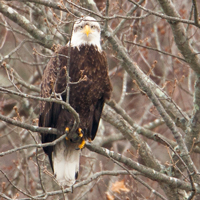
Bald Eagles on the Connecticut River
/ Mark Seth LenderView the page for this story
The Connecticut River is one place Bald Eagles gather to catch fish, but as writer Mark Seth Lender observed, they sometimes find other prey. (02:50)

Tornado Storm Kings!
View the page for this story
The vast majority of tornadoes touch down on the Great Plains of North America, tornado alley. Like many Midwesterners, Lee Sandlin has been fascinated by tornadoes since childhood. He joins host Steve Curwood to discuss his new book 'Storm Kings: the Untold History of America’s First Storm Chasers.' (14:45)

Whales at Home in the Caribbean
/ Bobby BascombView the page for this story
In the spring, humpback whales begin their annual migration north to the cold, food-rich waters of the North Atlantic. But they spend the winter enjoying the warm waters of the Dominican Republic. Living on Earth’s Bobby Bascomb reports. (04:00)
Show Credits and Funders
Show Transcript
Host: Steve Curwood
Guests: Pat Parenteau, Danielle Fugere, Fred Pearce, Lee Sandlin
Reporters: Ari Daniel Shapiro, Mark Seth Lender, Bobby Bascomb
[THEME]
CURWOOD:From Public Radio International, this is Living on Earth.
[THEME]
CURWOOD: I'm Steve Curwood. The White House moves to add climate to federal environmental impact statements, and investor watch dog groups warn that fossil fuel companies will lose big when the economy starts to price climate risk.
FUGERE: We think from within the next five to ten years we’ll start to see major carbon regulation and that means that these companies will be devalued significantly--by a third, 40, 50, 60 percent, some reports have said.
CURWOOD: They want companies to disclose such risks to their shareholders. Also, the trials and triumphs of morphing one tulip into another.
ZONNEVELD: You don’t know, if you make a cross, what to expect. That’s the nice thing, that you cannot predict what you get out. Each and every plant has a story.
CURWOOD: We'll have those plants' stories, a whale of a tale, and more this week on Living on Earth. Stick around.
ANNOUNCER: Support for Living on Earth comes from Stonyfield Farm.
President to Order Agencies To Consider the Climate

The Keystone pipeline may get another environmental review in light of the president’s new directive. (photo: bigstockphoto.com)
CURWOOD: From the Jennifer and Ted Stanley Studios in Boston, this is Living on Earth. I’m Steve Curwood.
President Obama has pledged to address climate disruption even if the Congress won’t, so he is rolling out an action plan based on existing laws, including the National Environmental Policy Act. More than 30 years ago Congress gave the President the power to require environmental impact assessments of the plans and projects of federal agencies ranging from the Forest Service to the Department of Energy.
Now the White House is poised to mandate climate security as part of those assessments, and that could mean trouble for a host of proposals including new power plants and perhaps the Keystone XL pipeline. Here to explain is Vermont Law Professor Pat Parenteau.
PARENTEAU: This will be a directive from the President to all of his executive branch agencies, and it would basically say, you have a new charge. When you're considering taking actions or authorizing developments, you must take the consequences of climate change into account, and that means in two respects.
One would be looking at whether the project will increase greenhouse gas emissions and whether that can be avoided, and the other would be, what are the impacts of climate change itself on, for example, land management or infrastructure projects like highways that might be built in coastal zones, that sort of thing.
CURWOOD: I need a history lesson here, Professor Parenteau. That involves how telling me how this new order relates to President Nixon’s National Environmental Policy Act, NEPA, which is a 1970 law.
PARENTEAU: Correct, it was signed by President Nixon in 1970. It basically says that for any proposal or major federal action that significantly affects the quality of the human environment, a detailed statement which has come to be known as an Environmental Impact Statement, must be prepared before the action is taken. It must be publicized for public comment, and it must accompany the decision-making process all the way up to the final agency decision. And then the regulations under NEPA require that the agency write a record of decision, which explains basically why the agency decided to proceed with the action that it proposed.
CURWOOD: So if I’m hearing you correctly, the NEPA isn’t going to stop one of these projects, but it sure is going to add a lot of time.
PARENTEAU: That's right, the Supreme Court has said that NEPA is a procedural statute, it requires disclosure of the facts, consideration of alternatives. In the end, the agency makes the decision, and it's not required to make the most environmentally beneficial decision, but it is required to at least think about what an environmentally preferable approach might be, and to disclose that to the public and others in this very public document.
CURWOOD: Which federal agencies are going to have the most work to do here? I’m thinking, what, Army Corps of Engineers, Surface Transportation Board, what other places?
PARENTEAU: Yes, the Army Corps of Engineers issues something on the order of 50,000 permits a year under the Clean Water Act for discharges related to various kinds of development - everything from real estate to energy projects. Surface Transportation Board has to approve new rail lines so all of the talk about exporting coal to Asia out of the Powder River basin in Wyoming and Montana are going to require new rail capacity as well as marine terminals to ship the coal overseas. That whole infrastructure from the mine mouth all the way to the coast and onto the ships overseas is going to require various forms of federal permits, approvals, perhaps financing.
CURWOOD: So the Export Import bank has a loan application, or guarantee application, in front of us to put up a coal-fired power plant in India. It would then have to consider the impact of the climate on that loan?
PARENTEAU: Yes, it would. In fact, the guidance that the President is indicating will be forthcoming from the Counsel on Environmental Quality would spell out in more detail what the content of those Environmental Impact Statements would have to have.
CURWOOD: What about the tar sands pipeline, the XL pipeline that has been proposed? And already, the State Department has had a supplementary Environmental Impact Statement for that.
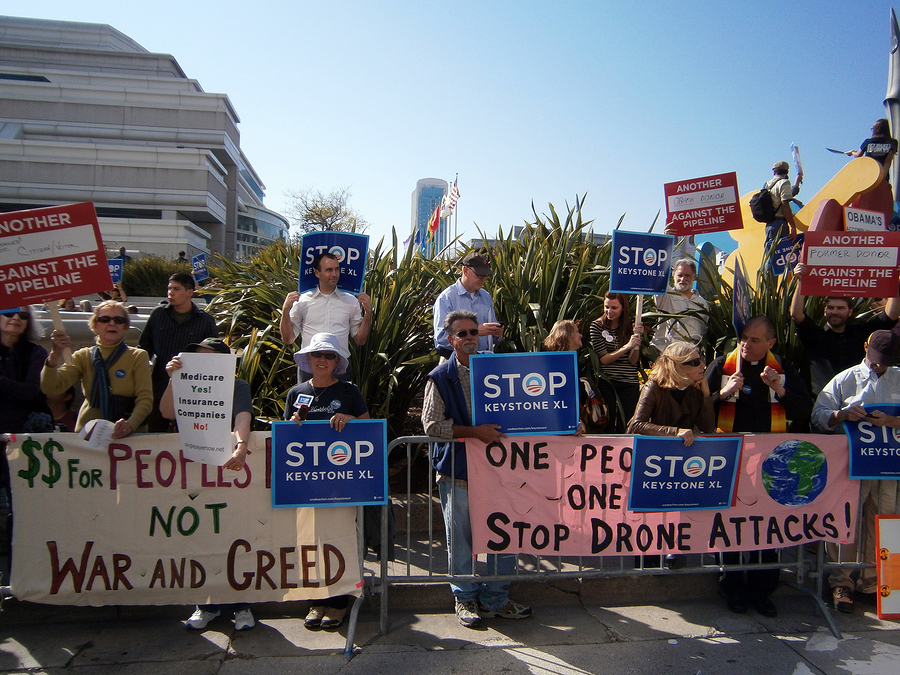
The Keystone pipeline may get another environmental review in light of the president’s new directive. (photo: bigstockphoto.com)
PARENTEAU: Right, and it's unclear whether this guidance that’s being talked about would have any effect on Keystone XL because it’s already at the draft Environmental Impact Statement stage. The State Department is getting an awful lot of public comment, much of it is quite negative because the State Department is taking the position the pipeline itself isn’t going to have a major impact on the environment or on the climate. In part, says the State Department, because even if we don't approve the pipeline, Canada will find a way to export tar sands through another means.
CURWOOD: Now there’s certain threats to climate change like rising seas. So would this apply to say plans to put a building up whether or not it might be overtaken by those seas?
PARENTEAU: It would. Sea level rise is one of the most visible signs of climate change. As the federal government looks at things like flood insurance in some of these high hazard areas, it needs to take account of the fact that the old floodplains are changing, and that the risks of increasing flood events is something to be taken into account, and deciding what kinds of developments are going to be eligible for that kind of federal assistance and which might not.
CURWOOD: What kind of a reaction are you seeing from industry groups?
PARENTEAU: The reaction is to be expected. The industry groups are concerned about delays in getting approvals for some of these projects, particularly things like pipelines and energy projects. They're concerned that maybe consideration of some of these effects might be speculative and uncertain. They’ve raised questions about whether this is necessary. If you're going to do the analysis properly, it will require time and effort, so there's bound to be some argument about whether spending this much time on it is worth it.
CURWOOD: Of course, one of the reasons that the President is taking this tactic is because any kind of climate legislation does seem to be DOA in the US Congress at this point. How is Congress responding to the notion of having a mandatory environmental impact statements for federal agencies that consider climate change?
PARENTEAU: In the House of Representatives controlled by the Republicans, there’s already rumblings of efforts to block the President from doing this, criticism from some quarters even at the suggestion of doing this. At this point I think it's mostly hand-waving coming from certain quarters in the Congress. Whether that becomes something more significant we’ll have to wait and see.
CURWOOD: Pat Parenteau is Professor of Law at the Vermont Law School. Thank you so much, Pat.
PARENTEAU: You're welcome, Steve.
Related links:
- The National Environmental Policy Act
- More about Professor Pat Parenteau
Shareholder Resolutions and the Carbon Bubble
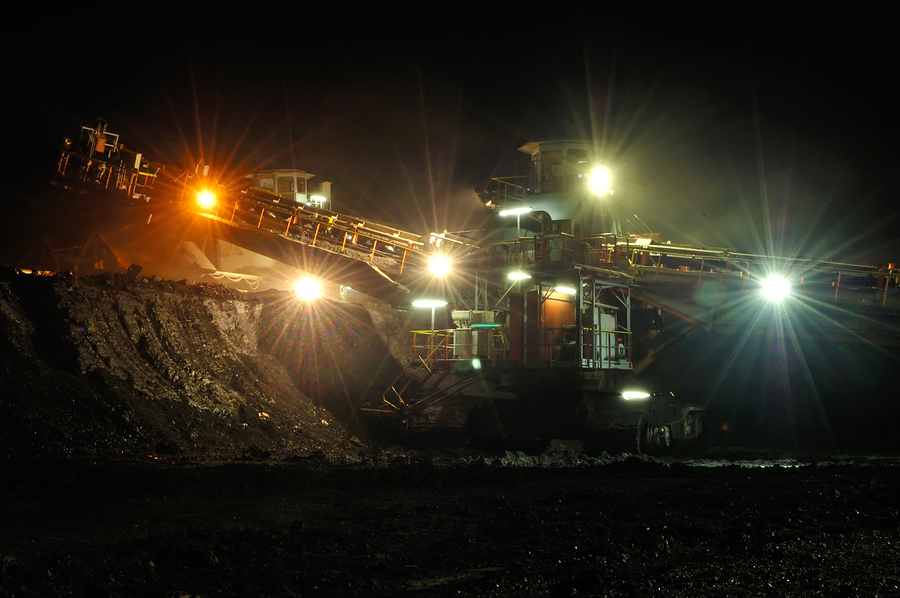
Coal companies would be hit hard by strict carbon regulation (photo: bigstockphoto.com)
CURWOOD: As the White House puts more pressure on the fossil fuel industry with regulations, activists are trying to hit it in the pocketbook and in the boardroom. Students at some 200 colleges are demanding that their schools divest their holdings in fossil fuel companies, and some stockholders are now calling these companies to account.
The Unitarian Universalist Association and the corporate accountability organization As You Sow have sponsored shareholder resolutions that ask energy companies to disclose their risk under stronger carbon regulation. Danielle Fugere, President of As You Sow, explains why shareholders need know about what’s called the carbon bubble.
FUGERE: Recent reports say we can only burn a third of the current world fossil fuel reserves without moving into the arena of climate catastrophe. Companies are valued on how many fossil fuels they have in the ground. Essentially, if you regulate fossil fuels, you will not be able to burn all of those reserves. That means these companies are overvalued; there's bubbles much like the housing bubble.
CURWOOD: And when you say bubble, it sounds like you think this will pop all at once.
FUGERE: Yes, I think it will pop. It may not be all at once, but it will happen very quickly. We think within the next five to ten years, we’ll start to see major carbon regulation. And that means that these companies will be devalued significantly - by a third, 40, 50, 60 percent, some reports have said. If they can’t sell their oil or sell their carbon, they can’t use all the infrastructure they’ve put all their money into. What happens to all the people who have invested in those fossil fuel companies? Essentially the house of cards comes tumbling down.
CURWOOD: So what’s the thinking behind the carbon bubble shareholder resolutions?
FUGERE: It simply asks these companies to do a report and look at what would be the impact of carbon regulation, look at their long-term and short-term financial and operational risks, and describe a range of scenarios in which some of their reserves are at risk of becoming stranded, and what they plan to do about it. Are they diversifying, or are they continuing to invest more and more money and capital in the fossil fuel reserves?
CURWOOD: And you filed this resolution involving a company called Consol. What is Consol?
FUGERE: Consol Energy is a primarily a coal company. But it’s a company that has also begun investing in natural gas.
CURWOOD: How big is it?
FUGERE: It provides right now about six per cent of US coal reserves. It’s got about 4.5 billion tons of proven coal reserves underground currently.
CURWOOD: In other words, say if coal is going for $100 a ton, that’s - like - almost a half a trillion dollars worth of coal.
FUGERE: That's right. We're talking some very, very large numbers, and this is just one coal company, and it isn’t the largest by any means in terms of fossil fuel companies, or even coal companies.
CURWOOD: How is the dialogue with Consol going?
FUGERE: Well, Consol is a company that is fairly forward thinking. They have talked with us about how they are diversifying the company, how they're actively trying to address some of these issues. They have not yet agreed to actually do the reporting that we’ve asked for. So they haven’t done the analysis of their long and short term financial risks. And whether the company is continuing to invest in new coal resources or investing in other arenas that would be more profitable given a carbon constrained world. Those are still issues we’re still talking about.
CURWOOD: But why is the company in your view not giving you this information? Why do you have to go the shareholder resolution route?
FUGERE: We don’t know that for sure. The company hasn’t said, but I can imagine that actually facing these issues is very difficult for a fossil fuel company because it’s really questioning the existence of these companies. Are these companies going to be in existence in 10 years, 20 years, 30 years? Will they be able to sell fossil fuels? And if they can’t, what are they going to do about it? So these are big questions, these are important questions. And frankly, I don’t think any of these companies want to address these risk scenarios and put them on paper.
CURWOOD: So what role do you think that shareholders have in the fight to slow climate disruption?
FUGERE: Well, how we invest our money is absolutely critical. Are we investing in the future, or are we investing in the past? Are we investing in companies that are moving on to deal with a climate constrained world? Or are we investing in companies that are using fossil fuels? They’re fossils! So we’re moving into a new world: we have to move into cleaner energy resources. That has to start happening now.
CURWOOD: Danielle Fugere is President of As You Sow. Thank you so much for taking this time.
FUGERE: Thank you. It's been a pleasure!
CURWOOD: We contacted Consol Energy for comment, but we've received no response to numerous phone calls and emails.
Related links:
- More about As You Sow
- As You Sow report on the financial risks of coal
- Shareholder Resolution—Consol Energy
- Unitarian Universalist letter to Alpha Natural Resources
- Consol Energy website
[MUSIC: Donald Fagan “Planet D’Rhonda” from Sunken Condos (Reprise Records 2012)]
CURWOOD: Just ahead...life and death on the frontlines of eco-activism around the world. Stay tuned to Living on Earth.
[CUTAWAY MUSIC: Christian Scott: “Van Gogh” from Christian Atunde Adjuah (Concord Music 2012)]
Murders of Eco Activists on the Rise

Fred Pearce (photo: Yale E360)
CURWOOD: It’s Living on Earth, I'm Steve Curwood. On February 17, upwards of 50,000 people marched on the White House to protest the Keystone XL pipeline. There were several arrests, but the demonstration remained peaceful.
Yet for many activists around the world, taking a stand for the environment comes at a high price. UK journalist Fred Pearce has just written an article for E 360, Yale’s online magazine, detailing the rising trend of assassinations of eco-activists around the world. Pearce says that 2012 may have been the most violent year yet.
PEARCE: The number of activists logged by international NGOs such as London-based Global Witness group has now reached more than two people a week, in other words, more than 100 over a year, which is more than double what they were logging over a decade ago. So it really doesn’t look good. More environmental activists don’t go into this business to become martyrs, still less to become dead, but for a significant number, that’s happening.
CURWOOD: Overall where are the most dangerous places?
PEARCE: Brazil has been dangerous for a long time. Cambodia has become more dangerous. The Philippines is extremely dangerous and has been for some time.
CURWOOD: Describe the situation in Brazil for us.
PEARCE: This last year I was attending the Earth Summit in Rio de Janeiro in June last year. And literally as most of the delegates including me were getting onto our plane, two activists who in the nearby bay, just literally to the west of the center of Rio, went out fishing and were killed while they were on their boats. Their bodies were found the next day. And those two people were activists in a group trying to prevent the laying of a new pipeline for natural gas and a new refinery that they believed would disrupt fishing. They were part of a group representing local fishing communities trying to prevent these industrial developments.
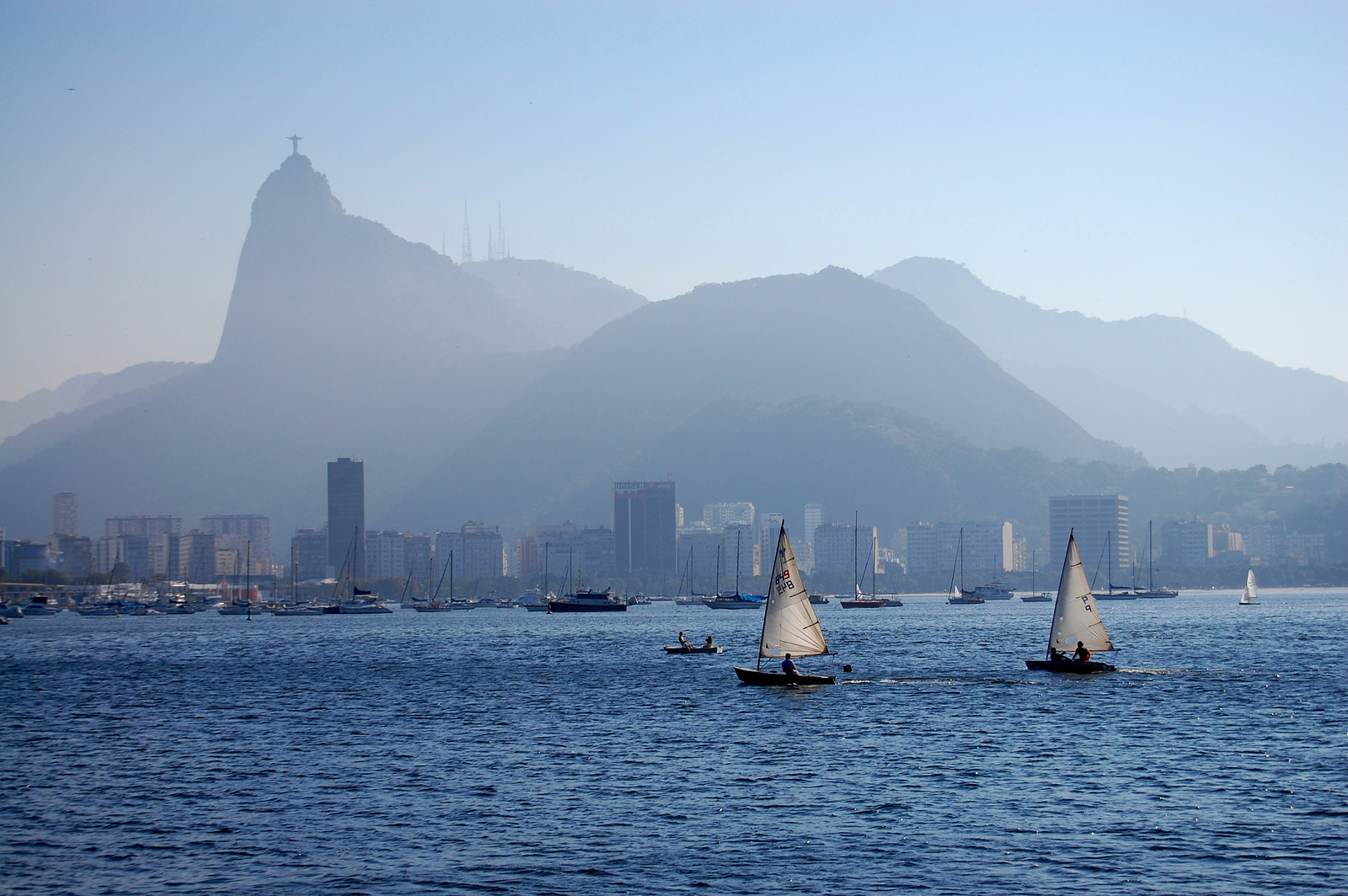
Guanabara Bay in Rio de Janeiro, where two environmental activists were killed in 2012 (photo: bigstockphotos.com)
CURWOOD: What happened to them exactly?
PEARCE: Well, one of them was found lashed to his boat and washed up on the shore the following morning, and the other one had been strangled. These were clearly brutal murders. The precise circumstances are unclear, and certainly the people who did it is unclear. But we know who they [the victims] were, we know what their political activism was, we know they went to sea, and we know their bodies wound up dead.
CURWOOD: And what about the Philippines?
PEARCE: There have been a number of cases of priests in the Catholic church quite prominent in social activism, and a number of those have been killed in recent years. Most recently, a civil servant who was active against a hydroelectric dam project in the southern island of Mindanao in the Philippines who was simply gunned down by someone on a motorbike after he had just come back from a village that was engaged in the protest against the dam.
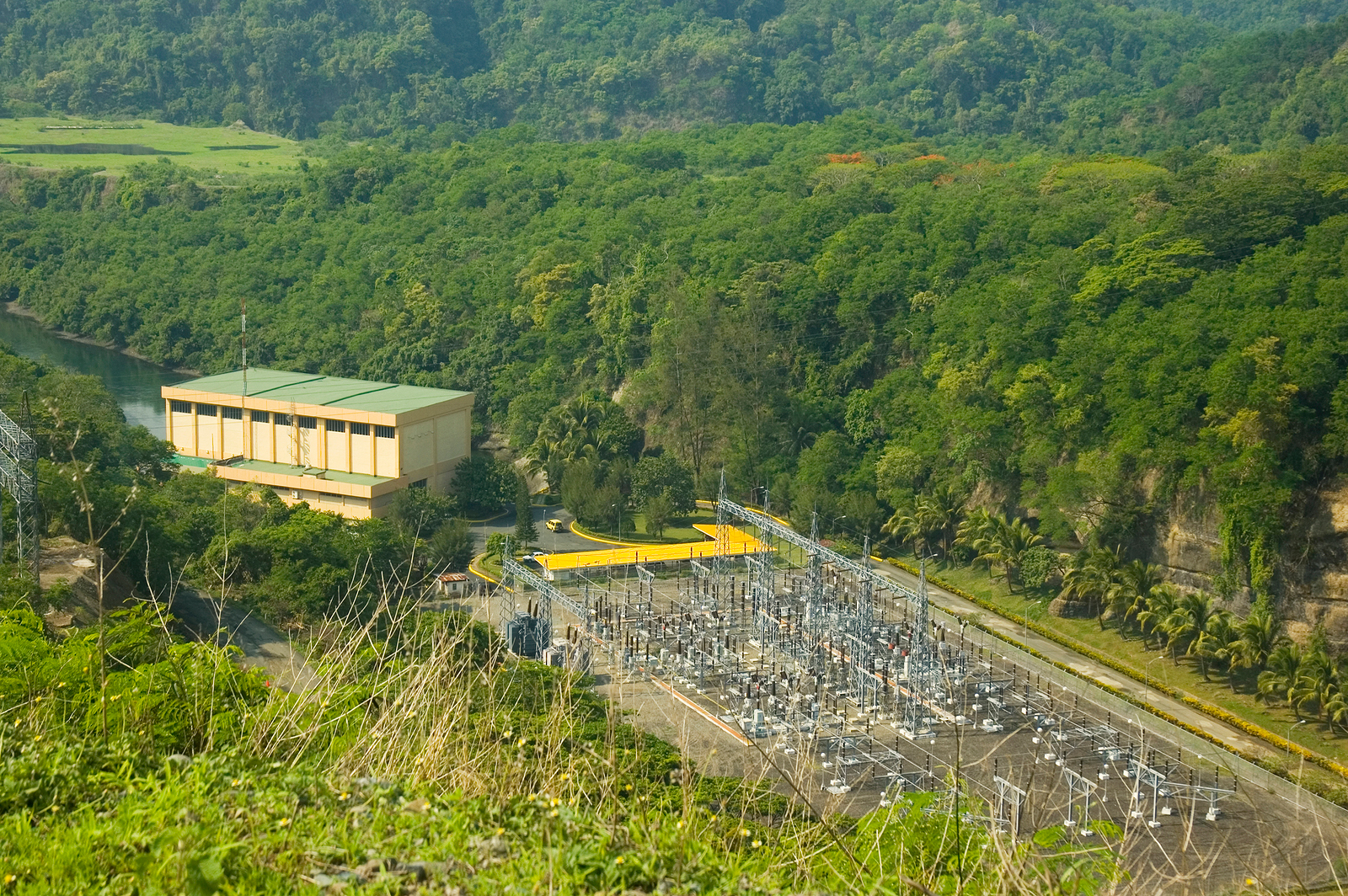
Pantabangan Dam in Nueva Ecija Philippines (photo: bigstockphoto.com)
Again one doesn’t know who did it, and there’s no sign of police finding a culprit. But it was an area were there had been quite a lot of tension, where a local military brigade had been active in the area and interviewing and arresting people who they regarded clearly as criminals, though the local activists in the area say they were simply engaged in opposing a controversial dam project which would have flooded their villages.
CURWOOD: What about Cambodia?
PEARCE: There have been a number of cases in Cambodia. Activists say that there’s been an upsurge of attacks of various sorts on environmental activists and one prominent death. The big issue there is illegal logging. There’s a great deal of the illegal logging going on in these surviving forests of Cambodia - people are making a great deal of money out of it. One activist called Chut Watty who had worked for Global Witness and a number of other international NGOs...he was taking journalists from Cambodia, the capital of Phnom Penh, to look for illegal loggers.
And they found some in the remote west of the country. And those loggers appeared to be supported, or defended - one doesn’t quite know - by government soldiers or possibly security people. At any rate, they stumbled upon this, what appeared to be illegal loggers in the forest, and before they knew where they were, Watty had been shot dead, the two journalists had run into the forest fleeing for their lives, and it appears somebody from the security services had shot dead the activist, and the forest ranger, in turn, shot dead the security person. All up to some extent conjecture because no case has ever come to court. But it resulted in - at any rate the activist wound up dead. And that sent a chill through much environmental and social activism in Cambodia because very clearly other people don’t want to find themselves in that situation.
CURWOOD: Why do you think it’s worse this year?
PEARCE: There are local circumstances always, but I think at a global level we’re reaching a kind of new crunch about a range of resources. We hear quite a lot about land grabs, foreign corporations and others moving in to try to take over traditionally owned land, whether it's farmland or pasture land or very frequently forests. There are conflicts about water issues and people trying to build hydroelectric dams. There are conflicts about mining schemes. Prices for many minerals and metals have been high for the last few years. A lot of companies are trying to move in on these resources. So there’s greater contesting of natural resources of one kind or another.
There was a case in Mexico where an entire extended family, or almost an entire extended family, some 20 people active against loggers and drug gangs, in the mountains of western Mexico were gunned down by various people over a period of three or four years for trying to protect their forest land. So you get these very difficult circumstances where conflicts rapidly turn to violence. And while one would not say that the activists are never at fault in any regard, some of them probably do have dangerous political links, in the main, these are people who are peaceful, who are active in trying to help communities peacefully defend their resources. And they’re coming up against people who are really far from peaceful.
CURWOOD: So at the end of the day, what do you think can be done to better protect environmental activists around the world?
PEARCE: I think we need to make a fuss when these things happen. The real danger is if people perpetrating these things, taking violence against legitimate activists, activities or just plain grassroots movements, if they think they can do this with impunity, they have to know that even if they’re not brought to book, there will be international concerns. The NGOs in Washington, in London, Rio de Janeiro, wherever it is, will make waves, will start asking questions. And if we as outsiders do that, it will certainly make it more difficult for the local authorities, governments, police forces to kind of walk away and pretend that nothing happened. If we’ve shined the light of international publicity on these sometimes heinous crimes, then I think there is a prospect to making people who are thinking of doing these things much more wary about the possible consequences.
CURWOOD: Fred Pearce is a freelance journalist based in London and an environmental consultant for New Scientist. Thanks so much, Fred.
PEARCE: Pleasure. Nice to talk to you.
Related links:
- Fred Pearce’s original article
- Fred Pearce’s page at e360
[MUSIC: George Clinton “We’re All Funkers” from Plush Funk (George Clinton Enterprises 1995)]
Creating Tulips

Tulips at Holland's famous Keukenhof garden. (Photo: Helen Palmer)
CURWOOD: The mention of a carbon bubble earlier in the show brings to mind one of the most celebrated and unlikely bubbles of history, the Dutch Tulip Mania of 1636-7.
The flowers had become a wildly popular luxury and status symbol, and speculation in tulips ran the prices up so high that at one point it took the annual income of a wealthy merchant to buy a single prize bulb. And then the tulip bubble abruptly popped leaving many in financial ruin.
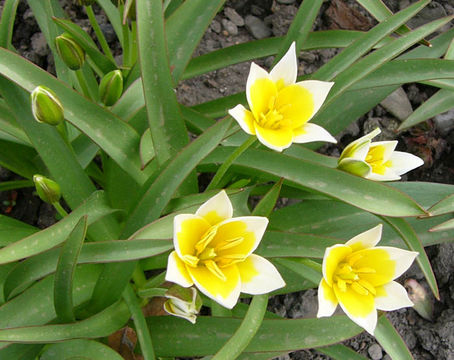
From Central Asia, Tulipa tarda, a native tulip used in creating modern hybrids. (photo: One Species at a Time)
Holland is still famous for its spring flowers, and on March 21st, the Keukenhof, the largest flower garden in the world, with seven million bulbs, opened with a tulip festival. As Ari Daniel Shapiro reports, some of the Dutch still can't get enough of tulips.
[SOUND OF PAIL OF RAZOR BLADES SHAKEN]
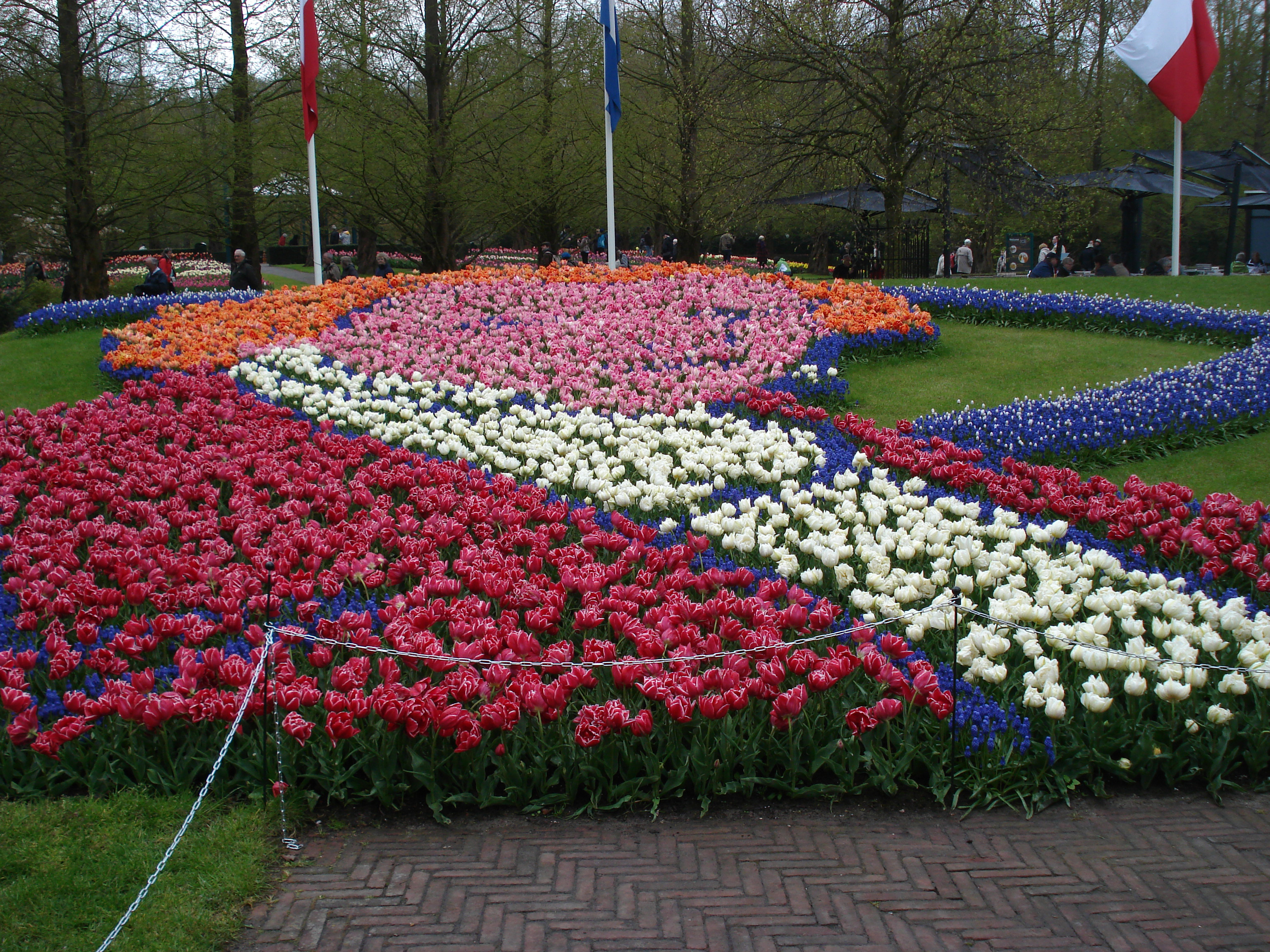
Each year, 7 million bulbs bloom at Keukenhof. (Photo: Helen Palmer)
SHAPIRO: Ben Zonneveld hauls out a pail of used razor blades – 40 pounds worth – and gives it a shake.
SHAPIRO TO ZONNEVELD: Oh my gosh, look at all those blades.
[ZONNEVELD LAUGHS]
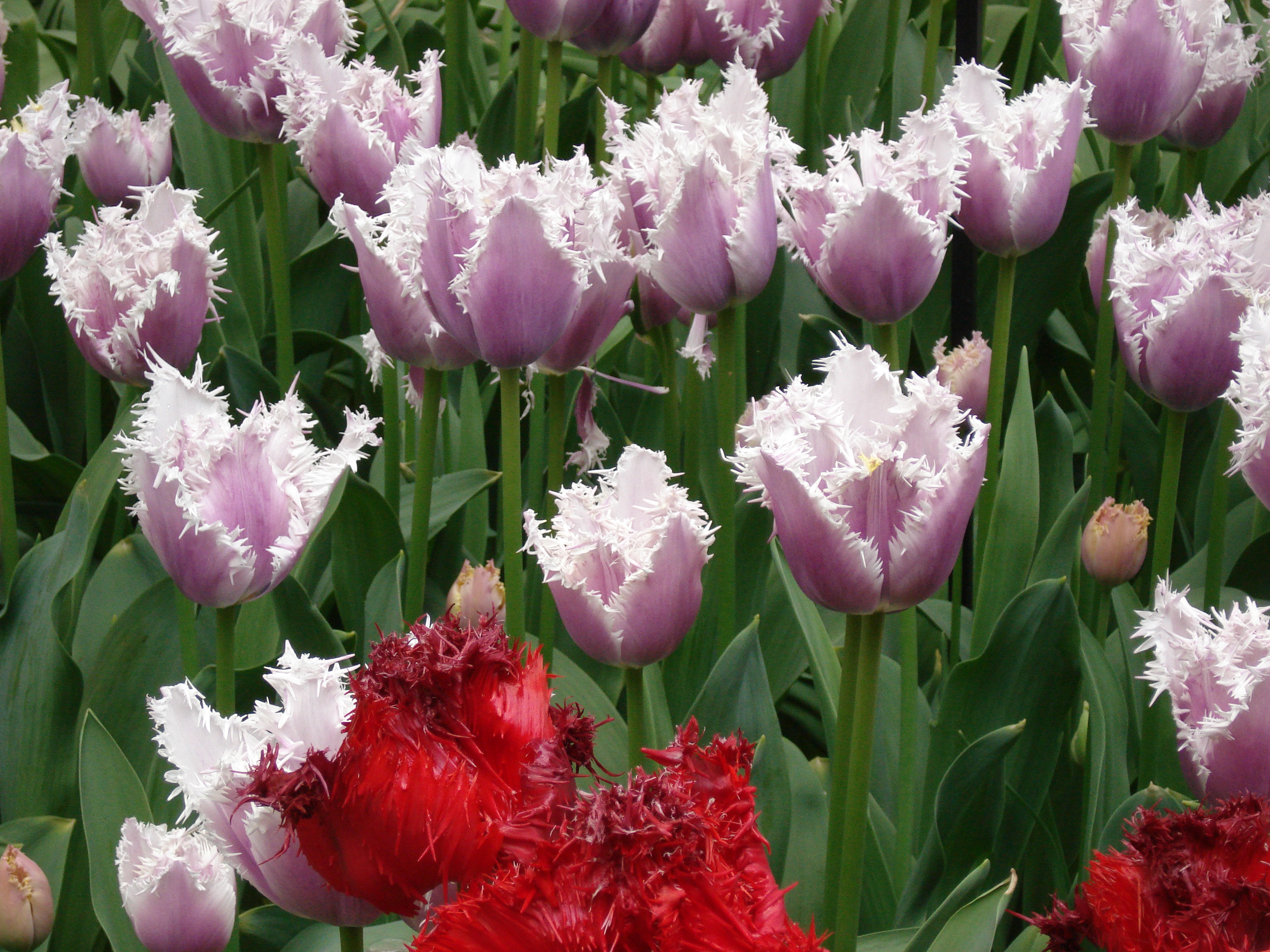
Parrot Tulips in Holland's famous Keukenhof. (Photo: Helen Palmer)
SHAPIRO: Zonneveld holds onto this bucket of blades as physical evidence of the progress he’s made. Progress, that is, on telling tulips apart - both wild and cultivated. He’s based at the herbarium at Leiden University, in the Netherlands - probably the country best known for tulips. In the springtime, bright stripes of color streak the Dutch landscape as tulips bloom before they’re cut and sold. But Zonneveld isn’t concerned with the colorful petals. He cares about tulip DNA. He’s a geneticist.
ZONNEVELD: What I do is measuring the total amount of DNA in a nucleus.
SHAPIRO: Different tulip species have different amounts of DNA. Anywhere from three to seven times as much in each of their cells compared to human cells.
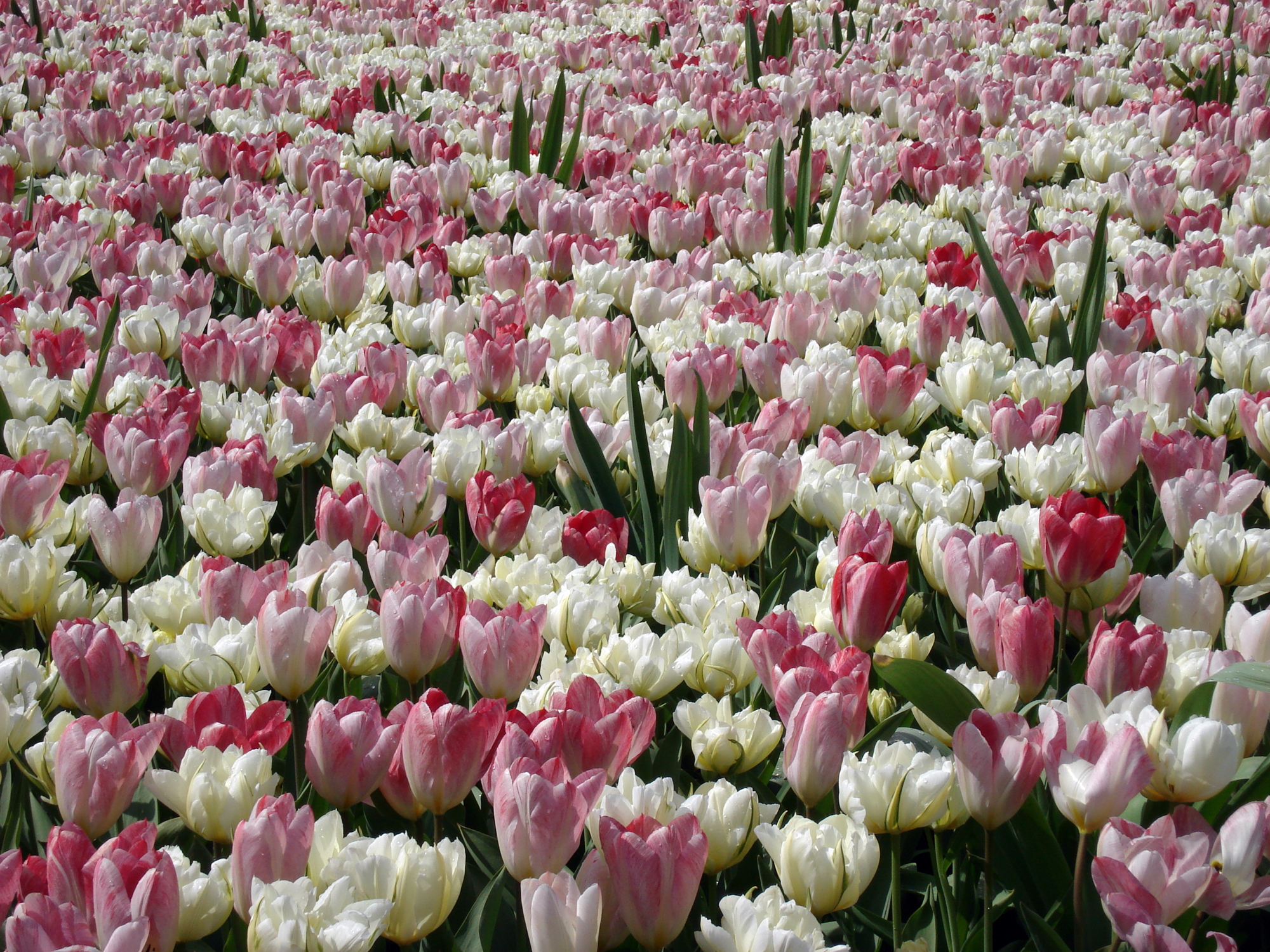
Keukenhof opened March 21st with a tulip festival. (Photo: Helen Palmer)
ZONNEVELD: The amount of DNA is not related to the complexity of the organism.
SHAPIRO: Why do tulips have so much more DNA than we do?
ZONNEVELD: I don’t know. Nobody knows.
SHAPIROi: Regardless, Zonneveld can use all that DNA inside the cell nucleus to distinguish one type of tulip from another, and that’s where all those razor blades come in. Zonneveld places a leaf in a petri dish and starts slicing it up.
[CUTTING SOUNDS]
ZONNEVELD: All organisms are built from cells, plants and animals. Each cell contains a nucleus, so I need the nucleus so I have to cut up the cells. For me, it’s very convenient that I’m not left-or right-handed, but I can do it with both hands.
SHAPIRO: When Zonneveld stops, the leaf’s been reduced to a droplet of green slurry. The next step would be to add a fluorescent dye. The more DNA there is, the more it glows. Zonneveld used this technique to distinguish between 87 kinds of tulips - more than any previous classification attempt. Everything from the pink and white Tulipa Clusiana.
ZONNEVELD: A very elegant tulip.
SHAPIROi: ...to wild tulips growing in the Middle East and central Asia. It took four or five years for all the samples to trickle in. And after he catalogued and published the 87 types, he discovered an 88th – a new tulip. He holds up a dried specimen – the flower’s white and yellow.
ZONNEVELD: This is the picture of the new tulip.
SHAPIRO: What’s the name of it?
ZONNEVELD: Kolbintsevii.
SHAPIRO: Zonneveld named Tulipa kolbintsevii after Victor Kolbintsev – the nature guide in Kazakhstan who introduced him to the tulip. Zonneveld subjected its leaves to the razor blade treatment as well. But Zonneveld doesn’t just tear plants apart. He also puts new ones together. When he’s not in the lab, he’s usually at home, in his garden.
[DOOR OPENING]
SHAPIRO: Zonneveld holds open the door to his tiny backyard greenhouse and leads me inside. He loves it in here.
ZONNEVELD: It is, well, rather packed with plants.
SHAPIRO: This is really beautiful – I mean, it’s like a little forest in here.
ZONNEVELD: Yes, yes.
SHAPIRO: The potted plants are tucked into this room like a tight jigsaw. There’s absolutely no space to move around.
ZONNEVELD: I think just here I have 2,000 different plants.
SHAPIRO: 2,000 in this little room?
ZONNEVELD: Yes, and there’s not a single one in here twice because I don’t have the space. Each one is unique.
SHAPIRO: Most of the plants in here are new varieties, or crosses, that Zonneveld made. They don’t exist anywhere else in the world except in this greenhouse.
ZONNEVELD: I can show you how you make a cross, if you want. You take a flower.
SHAPIRO: You just took a little pink blossom.
SHAPIRO: Zonneveld peels the petals back. He would then dab the pollen from this flower onto the female organ of the flower of a different species. Half the time it doesn’t work. But the other half – Zonneveld gets seeds.
ZONNEVELD: You don’t know, if you make a cross, what to expect. That’s the nice thing, that you cannot predict what you get out. Each and every plant has a story.
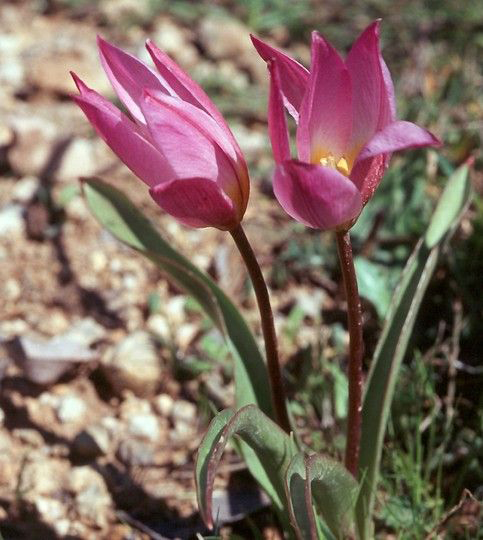
From the island of Crete, Tulipa bakeri, known as “Lilac Wonder.” (photo: One Species at Time)
SHAPIRO: He points out plant after plant, and tells me the stories – how they came to be. How he’s mixed colors and sizes and shapes, and produced something new over and over again. And he has even more time for his hobby now, because he’s 71, and retired.
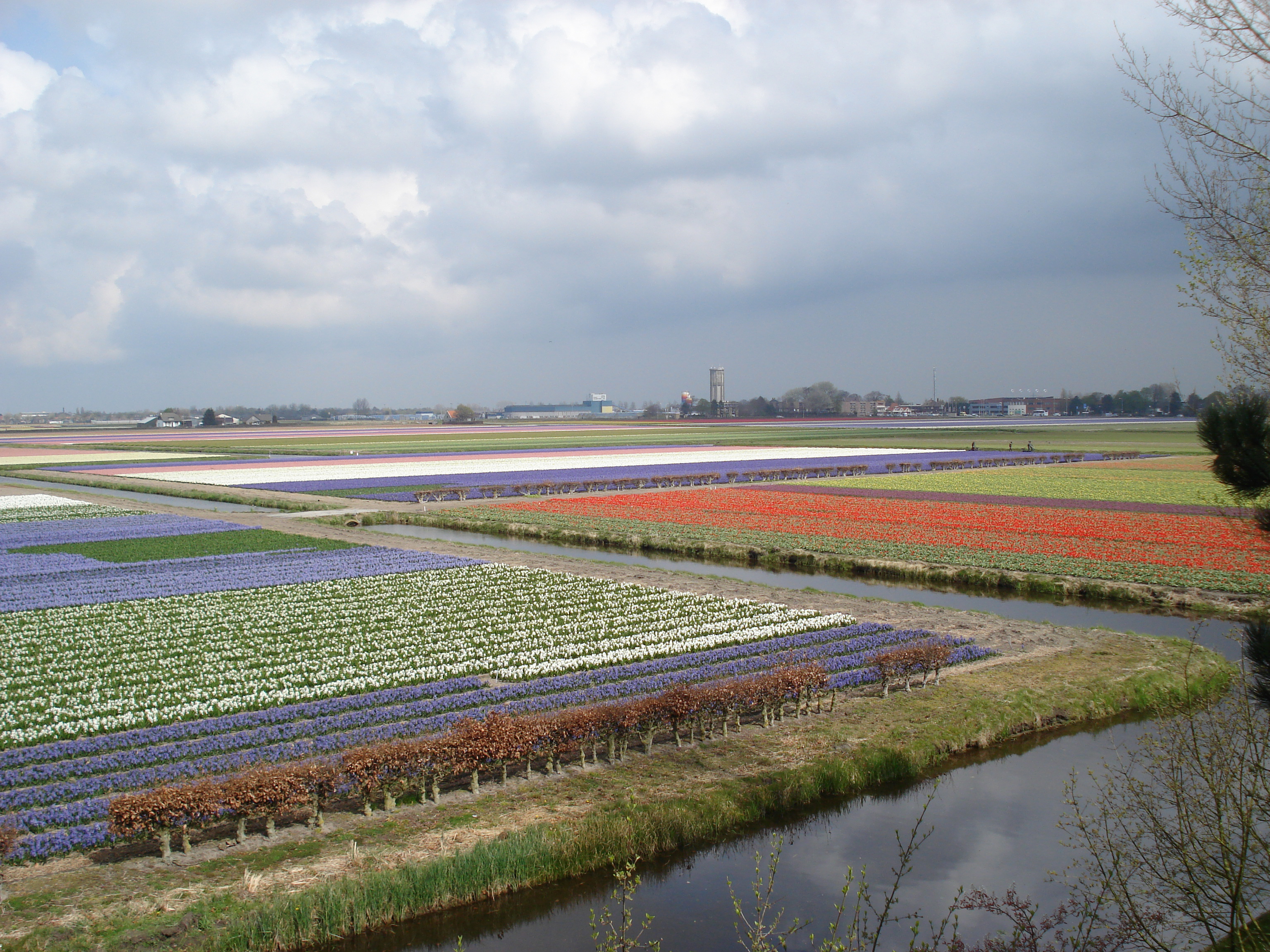
Fields of spring flowers at Keukenhof garden. (Photo: Helen Palmer)
ZONNEVELD: My wife says I have too much plants, and I cannot part with any one because most of these I have quite a lot of work involved. I had to grow them up, wait until they flower, make the crosses, sow the seed, grow the seedlings up.
SHAPIRO: They’re like your children.
ZONNEVELD: Yes, yes, more or less.
SHAPIRO: For Living on Earth, I’m Ari Daniel Shapiro.
CURWOOD: Our story about tulips comes from the series “One Species at a Time”, produced by Atlantic Public Media, with support from The Encyclopedia of Life. Check out the pictures at our website, LOE.org.
Related links:
- Keukenhof website
- One Species at a Time website
Bald Eagles on the Connecticut River

An Adult Bald looks Mark Seth Lender in the eye. (photo: Mark Seth Lender)
CURWOOD: The American Bald Eagle prefers to eat fresh-caught fish. And in winter, when the upper reaches of the Connecticut River freeze over, the eagles move south in search of open water. To get a good view of these iconic birds requires a good boat, and a good captain, says writer Mark Seth Lender, who found both on the Connecticut River, aboard the Riverquest - and plenty of eagles as well.

2-Juvenile-Eagles,-8-Mile-Bar-DSC_3614.jpg
LENDER: Under clouds like a lead yoke, sun rises over sea smoke, painting color on the sky. Up the river over ice floes, at the bloom of the dawn rose, bald eagles rub their eyes. In their cold perches on the dead branches of the riverside hemlocks, in the red raw hour as the day flowers they are hardly alive. Not a talon reaches. Not a wing stretches. Not a sparrow flies.

A lone juvenile eagle scans the horizon (photo: Mark Seth Lender)
This was a rich place once, Connecticut River Salmon and Sturgeon, Shad and Menhaden racing against the tidal flow. In that time, up where the coves creep down and the River narrows, from salt to sweet, over falls and shallows salmon spawned and died, while the great Atlantic sturgeon used to glide sowing seed to the River for a century and more.

Adult bald eagle with a Merganser foot trailing from its talons. (photo: Mark Seth Lender)
Silent giant oak and tall pine in galleries along the riverside held the banks upright. We felled them for our ships. Astride the great stream, we quarried the islands, carved them like carcasses to ballast those ships in granite blocks grey as tomb stones. We reaped the fish with mile wide nets (billowing shadows of the Shadow of Death) and when there was nothing but emptiness we ground the last of the herring down to feed, and to fertilizer for our corn rows.

Juvenile bald eagle in flight (photo: Mark Seth Lender)
But the eagles know none of this. Care for none of this. Two fathom wide of wing spread between them, the Young Princes prance upon the sands of 8 Mile Bar. While above them, determined and speeding, the white head gleaming, her gunmetal talons long as a Bengal tiger’s claw, there she flies, Queen of the Air! And trailing behind her in her gnarled and yellow grip where the scales and the flailing tails of fishes belong is instead the webbed foot of a merganser, fresh killed. Red as murder.
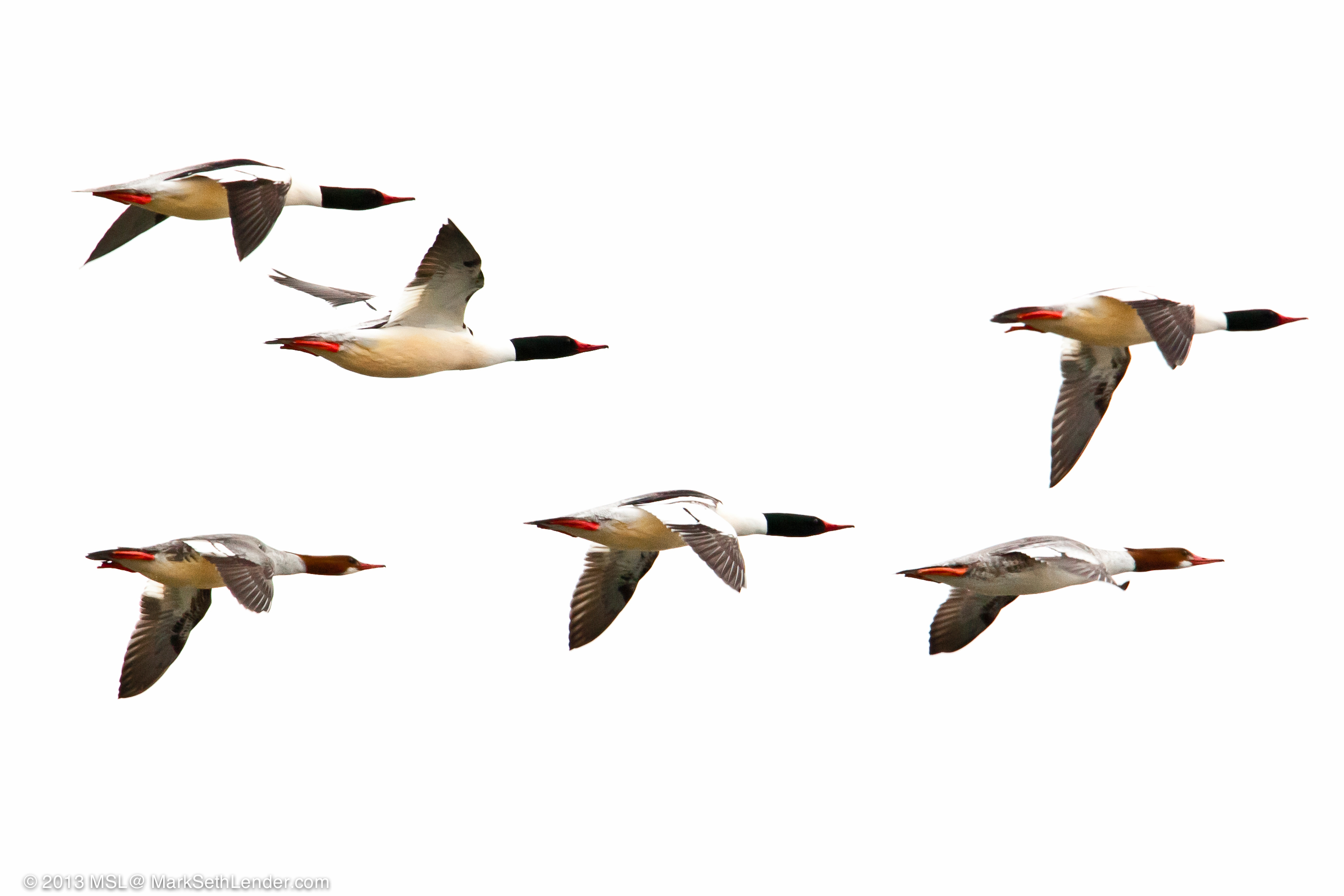
Common Mergansers in flight (photo: Mark Seth Lender)
CURWOOD: Mark Seth Lender is the author of Salt Marsh Dairy, A Year on the Connecticut Coast. For the photos he took of our national bird, head on over to our website, LOE.org.
Related links:
- Mark Seth Lender’s website
- Riverquest website
[MUSIC: Charles Lloyd “Journey Up River” from Hagar’s Song (ECM Records 2013)]
CURWOOD: Coming up...catching up with humpbacked whales in their lovenest in the Caribbean. That's just ahead here on Living on Earth.
ANNOUNCER: Funding for Living on Earth comes from the Grantham Foundation for the protection of the environment. Supporting strategic communications and collaboration in solving the world’s most pressing environmental problems. The Gordon and Betty Moore Foundation. The Kendeda Fund, furthering the values that contribute to a healthy planet, and Gilman Ordway, for coverage of conservation and environmental change. This is PRI, Public Radio International.
[CUTAWAY MUSIC: Various Artists/Vitamin Piano Series: “(Don’t Go back To) Rockville” from Piano Tribute to R.E.M. – Fragile (Vitamin Records 2005)]
Tornado Storm Kings!
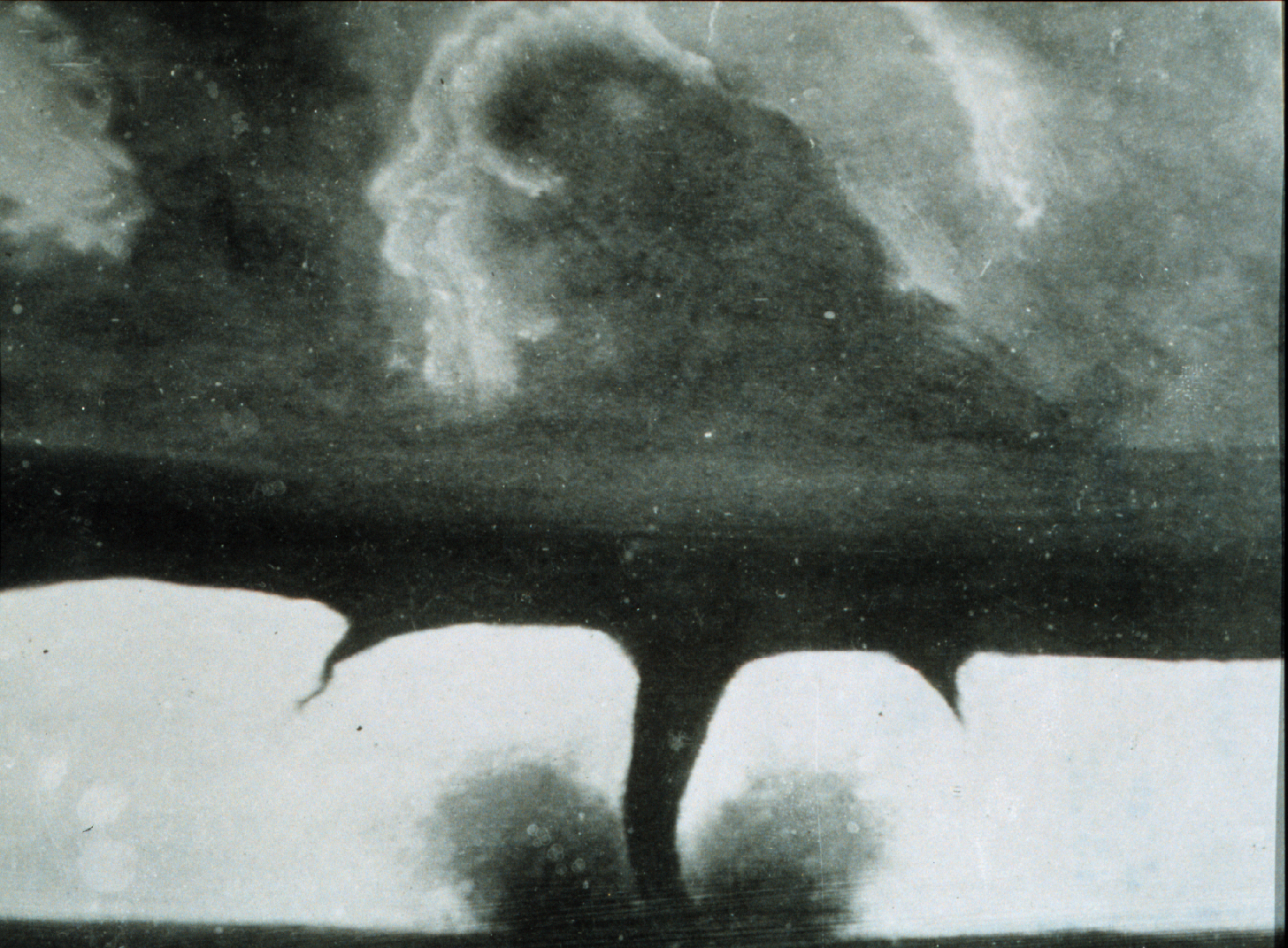
The earliest known tornado photograph, taken in South Dakota in 1884, heavily retouched for sale as a postcard. (Photo: NOAA)
CURWOOD: It's Living On Earth, I'm Steve Curwood. From The Wizard of Oz to Twister, tornadoes loom large in the American imagination, and throughout our history. Lee Sandlin’s new book “Storm Kings: the Untold History of America’s First Tornado Chasers” outlines the history of tornado science and describes some of the worst tornadoes in U.S. history. Lee Sandlin says his interest in deadly storms began as a child, growing up in tornado alley.
SANDLIN: When you grow up in the midwest, you're always aware of tornadoes in a way that people elsewhere in the country really aren’t. You get tornado preparedness in schools, people tell you stories about tornadoes that they saw when they were children. It's this kind of ongoing fact of life.
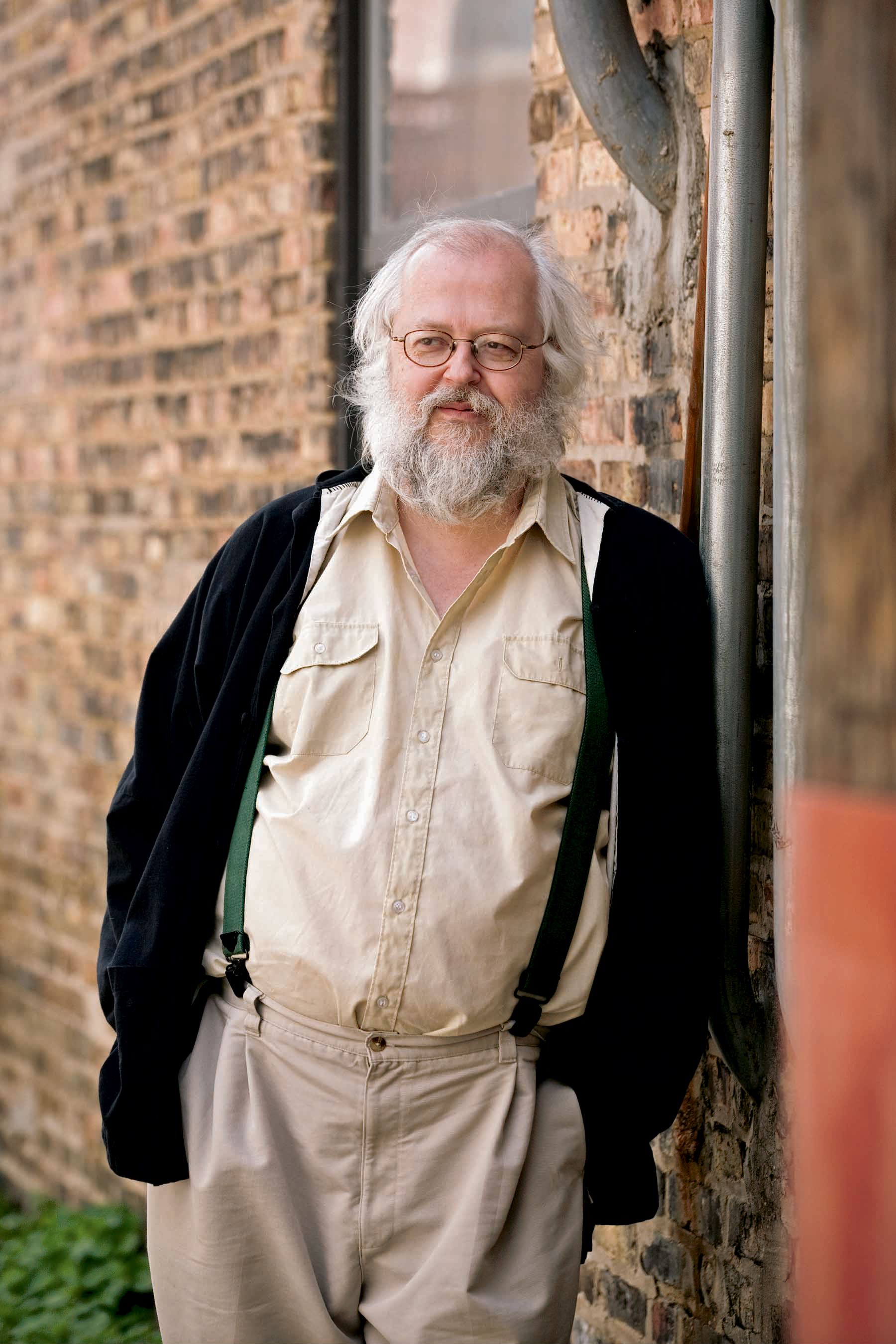
Lee Sandlin (photo: Peter Wynn Thompson Photography)
CURWOOD: Tell me about the tornadoes you've witnessed yourself.
SANDLIN: I was in a small tornado when I was 17 years old. I was just at home. It was a summer day. It had been raining all day. And then suddenly it turned sunny and clear and I thought I’d go out for a walk. I was standing at the door of my house literally about to step outside. And I was looking out through the screen door and the street immediately got pitch black. And every single thing that wasn't nailed down was swept up straight into the air.
Now this was a weak tornado, but it was terrifying enough that it's stuck with me. And the other lesson I took from it was that you can be in a tornado and not really realize what's happened because they move so quickly that a lot of the stuff we think of as characteristic, like a funnel cloud - you often don’t see it. I didn’t see it. If I hadn’t know intellectually that it was a tornado I would have had no idea what was happening.
CURWOOD: Now one of the most interesting things that I took away from this book was the realization that, at least for people who came from Europe and Africa, tornadoes are totally unfamiliar. Why are tornadoes such a uniquely American - North American phenomena?
SANDLIN: It's a freak of geography actually. What you need for tornado formation are two different kinds of air masses meeting. One, you need very cold dry air, and for the other you need very moist humid air and hot air, and the American Midwest where you have air coming down from Canada and air coming up from the Gulf of Mexico are the perfect conditions for tornado formation. And the other factor too is there no mountain ranges in the Midwest. There are no details of landscape or crosscurrents of air that will dilute the effect of these two air masses meeting. So you tend to get these extraordinarily strong destructive storms forming there.
CURWOOD: Now, tell me...who was the very first storm chaser?
SANDLIN: Well in the literal sense of chasing the storm, the first person I found out who did it was Benjamin Franklin of all people.
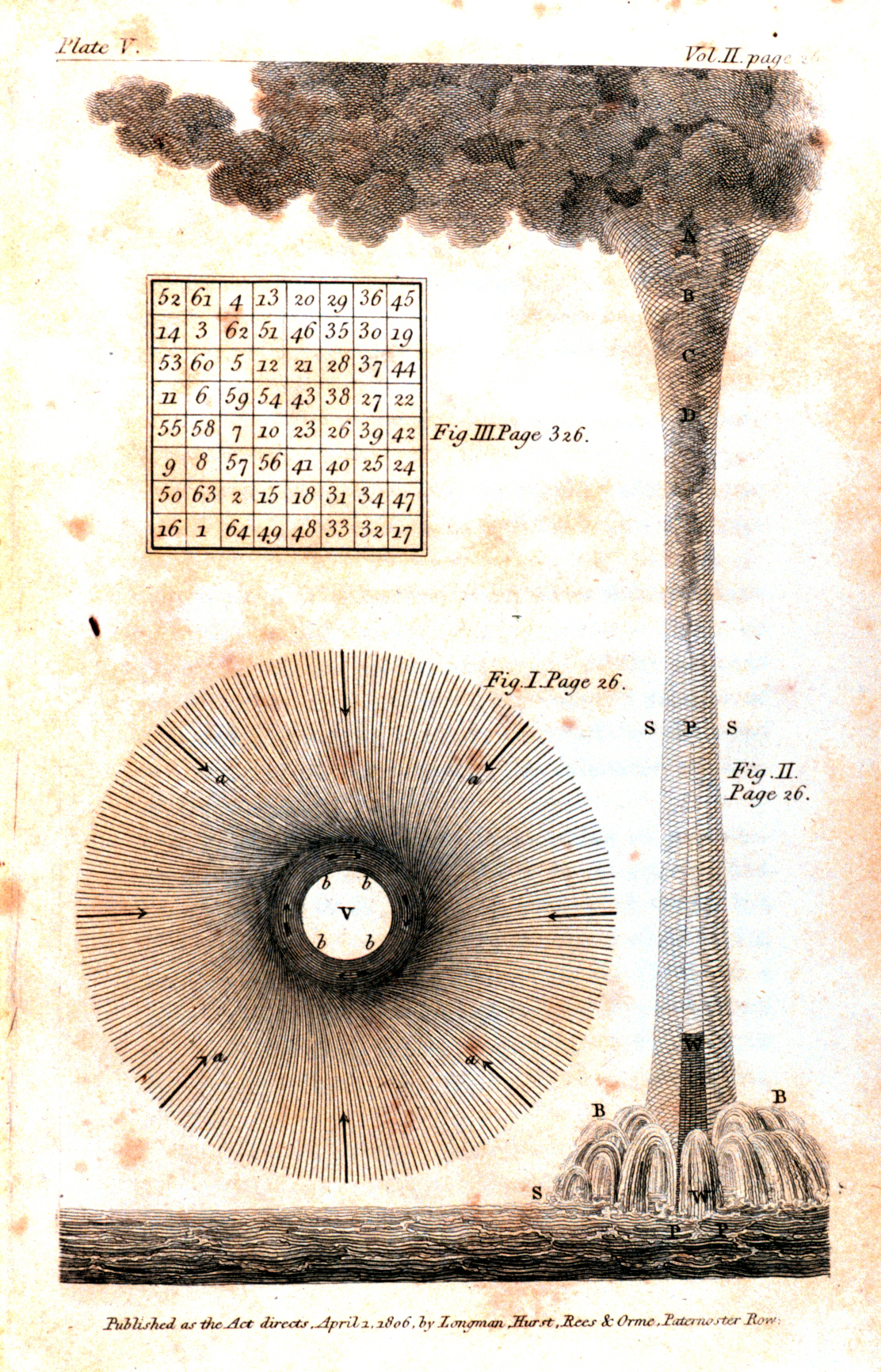
Benjamin Franklin’s conception of a waterspout. (Photo: NOAA)
CURWOOD: The guy on the 100 dollar bill?
SANDLIN: You got it. He had a brief period where he was fascinated by tornadoes. And he, just out of a fluke, he happened to see one forming. It was a very small tornado. When he and a bunch of friends were out riding, everyone else was frightened, but he went off riding on horseback chasing this tornado through the forest and so that’s the literal beginning of tornado chasing as a hobby.
CURWOOD: Did he catch up with the storm?
SANDLIN: He said...he claimed that he got so close to it that he was able to lash it with his riding crop. I don't know, he may have been exaggerating just a little bit there. He got pretty close to it, but it was a very weak tornado and it broke up fairly quickly, so nobody was hurt. He was fine. But he was exhilarated by it and that fuels his fascination for quite a while.
CURWOOD: In your book you describe the great storm war that was a debate between meteorologists over the causes of tornadoes
SANDLIN: Yes, in the early 19th century.
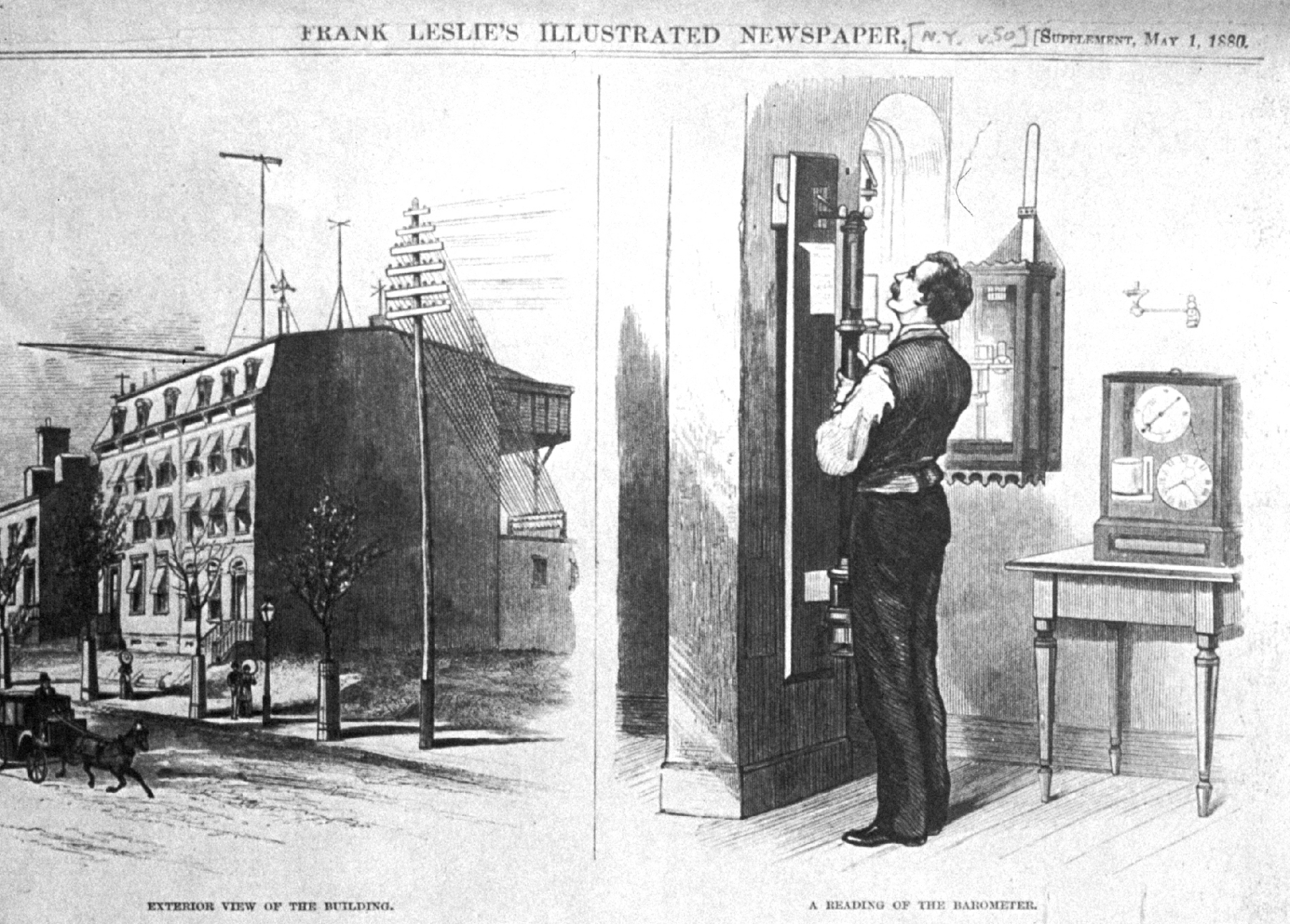
The Signal Corps headquarters in Washington City, 1880. (photo: National Oceanic and Atmospheric Association, NOAA)
CURWOOD: Describe that debate for us. Who was involved, and what was the disagreement?
SANDLIN: Well, this is really kind of one of the peculiarities of the history of American science. There were two great experts on storms in the early 19th century. One was a man named Espy and the other was a man named William Redfield. Espy was...he considered himself America’s first professional meteorologist. Redfield was more of an enthusiastic amateur.
Espy was the person who realized the core mechanism of the tornado, which is a phenomenon called convection, a rising column of air in the atmosphere. And this is a major scientific breakthrough - he doesn’t get as much credit for it now as there used to be, but he figured that out.
And Redfield also made a dramatic, dramatic breakthrough. He was the first person to realize that storms like tornadoes and hurricanes rotated, which is something that nobody had believed before.
So you had these two guys - one of them thought a tornado was a rising column of air. And the other thought a tornado was a rotation on the ground. And they detested each other. And they disagreed with each other. And they refused to believe that the other could be right. And so they spent two decades feuding in scientific periodicals over which one was right. And it couldn't be resolved, because the truth is that they were both right, but neither was able to concede that the other might have a point. And this fight really paralyzed meteorology for the first half of the 19th century.
CURWOOD: So, a little science lesson here. Talk to me about convection, and how it’s related to tornadoes.
SANDLIN: Sure, the easiest way to picture this is that if you've ever noticed when you're looking at a pot of boiling water on the stove, when it begins to boil, you’ll see little bubbles coming up from the bottom. The bubbles don't appear randomly. They tend to appear in, like, single file lines rising through the water. So what's happening there is hot water at the bottom is rising through the colder layer of water to the surface.
Now the exact same thing can happen in Earth’s atmosphere. The air near the surface can be very warm, and the air above very cold - which is a very unstable relationship because hot air rises just like hot liquids rise. And the result of that, tornadoes are essentially kind of a safety valve mechanism by which very, very large amounts of hot air at the surface move very, very quickly through cold air into the upper air, and so it’s a way of restoring atmospheric equilibrium.
CURWOOD: It’s funny you call this is a safety valve. I don’t think anyone would think much of...
SANDLIN: Around the surface, no, they’re horrible. But it is true that almost everything in nature tends to look for equilibrium, and that's a way of restoring equilibrium to a violently unstable situation.
CURWOOD: Talk to me about James Espy. He comes across as a particularly interesting figure in your book.
SANDLIN: He was the first celebrity meteorologist.
CURWOOD: You write that he actually thought he could control the weather. I mean, what was his idea?
SANDLIN: Well, he thought storms formed because hot air rose from the surface into cold air aloft and that the moisture in the hot air would shed out and fall as rain. Now that is a fact, exactly correct. But he drove a strange consequence from that because he thought if that's true and he really wanted to get hot air rising in cold air, what would you do? You’d build a fire. And if you built a big enough fire, you could create storms over a very large amount of the country.
He was convinced that if they built fires all through America they could control the weather. He was quite serious about this. He worked out maps as to where all the fires should all be set and they would be burning permanently. He said it would cure and permanently end droughts in America; it would let people control where the rain would fall and where it wouldn’t. And he thought - this would be in one stroke - we could remake the entire American landscape using this method.
And the odd thing about this story is that everybody then just assumed he was nuts. No one took the idea seriously, but he wasn't technically wrong. Very large fires - this is not really well-known - but very, very large intense fires do create thunderstorms. What he didn't realize is that even though he could create storms that way, it would be inherently unstable. It was also just a basic problem that he refused to think through...which is the worst thing you want to do in a drought area is build a really big fire!
CURWOOD: In your book, you write that fire can trigger a tornado. You tell us the story of the Peshtigo fire tornado of 1871.
SANDLIN: Yes. The Peshtigo fire tornado is one of the most catastrophic weather events on record. It was a storm that formed at the heart of an immense forest fire in northern Wisconsin. At the heart of the fire, this column of air seems to have formed into a tornado. And the tornado was so intense that it started drawing the flames of the fire into itself and it moved through the forest as this titanic column of flame.
It came over the town of Peshtigo and destroyed it almost instantly. It tore full steam engines, rail engines, off the tracks and smashed them in midair. It blew up every house, every structure that it came across, and went instantly up in flames. 1,500 people died. Survivors, the only survivors, had plunged themselves into the river and stayed submerged as the tornado passed directly over. It was an absolutely catastrophic event.
CURWOOD: Now as the National Weather Service gets going, tornado prediction becomes extremely controversial. Why?
SANDLIN: Well, there were two reasons. One, I think was a good reason and one was not so good. The good reason was that tornado prediction was a very crude science and people believed that predicting tornadoes could cause panic, that it could be worse than the actual tornadoes. The other reason was that the weather service was being pressured by business interests and real estate people in the Midwest who did not want the idea spread that tornadoes were real problem. So they were pressured to underreport tornadoes, in fact for a long time for several decades the weather service banned forecasters from the word “tornado”.
CURWOOD: We have tornado warnings today. What changed?
SANDLIN: Well what’s changed specifically is that after World War II, the Air Force came up with a method of predicting tornadoes that they were keeping to themselves. It really was very crude technology. All they actually had to work with were reports from weather spotters and from other weather stations and a radar which they had salvaged from a World War II vintage bomber.
They tried to get the National Weather Service interested in it, but they wouldn't do it, and the news got out sort of through underground channels. What would happen is that when they had these tornado forecasts issued, people on the Air Force bases would call their relatives who were civilians and tell them about the warnings, and gradually through Oklahoma and Texas in the early 50s, the word spread that the Air Force had this secret tornado predicting facility, and there were congressional hearings about that, and that led to the National Weather Service lifting their tornado ban.
CURWOOD: Now to this day tornadoes remain, of course, dangerous, and difficult to predict. Think of Joplin, Missouri, 2011, that tornado killed more than 160 people.
SANDLIN: Yes, it did. The thing about that tornado is in some ways the most alarming is that the weather system, prediction system, as it exists now, worked very well. They had a lot of lead time. They had a lot of warning, and people still either didn't believe it or ignored it until the tornado was right on top of them. And also another factor which is a growing problem in the midwest, is that the midwest is getting very heavily built up, and most of the new residential construction has nothing that would serve as a good tornado shelter; no basements, no interior closets, no storm cellars... people are essentially building, pretending that tornadoes don't exist. And so in Joplin, even people who wanted to take shelter often couldn’t find any shelter to take. So it feels in some ways like we’re going backwards with tornado preparedness.
CURWOOD: So what are the myths that still persist about tornadoes?
SANDLIN: Certainly when I was kid, everything they told us in school about tornadoes was wrong. They told us to hide in the southwest corner of the basement. That was a famous one when I was child. They told us to open windows when tornadoes approached because there was a vacuum at the center of the funnel and the air pressure inside the building would push outward and cause your house to explode. Now that idea is completely false and dated back to the 19th century and nobody never examined it.
CURWOOD: And what other myths do we have about tornadoes?
SANDLIN: Oh, that tornadoes don’t go into cities which is false, that they can’t cross rivers, that they won't go up and down hills. These are all ideas that are very dangerous to trust.
CURWOOD: So how much tornado chasing do you do now?
SANDLIN: Well, I don't do any now, and I've only done a little mostly in an amateur level back when I was younger. But it’s becoming this huge, huge industry now. A tornado chaser once told me that the biggest danger from tornado chasing isn't the tornado itself - it's getting rear-ended by another tornado chaser. It’s almost like a spectator sport, and if you look at YouTube there's a whole vast genre of amateur video of tornadoes actually called “torn porn”.
CURWOOD: What effect is climate change having on tornadoes?
SANDLIN: Well that is the big question, and I'm afraid the answer is nobody knows. Tornadoes don't appear to be growing more prevalent. It’s just our detection systems are more prevalent. But you know, climate change means the atmosphere is becoming more unstable, and since tornadoes are the product of instability, it's at least possible that what's going to happen is that we’re going to be seeing more tornado outbreaks, but no one knows that for sure yet. We're just going to have to wait and see.
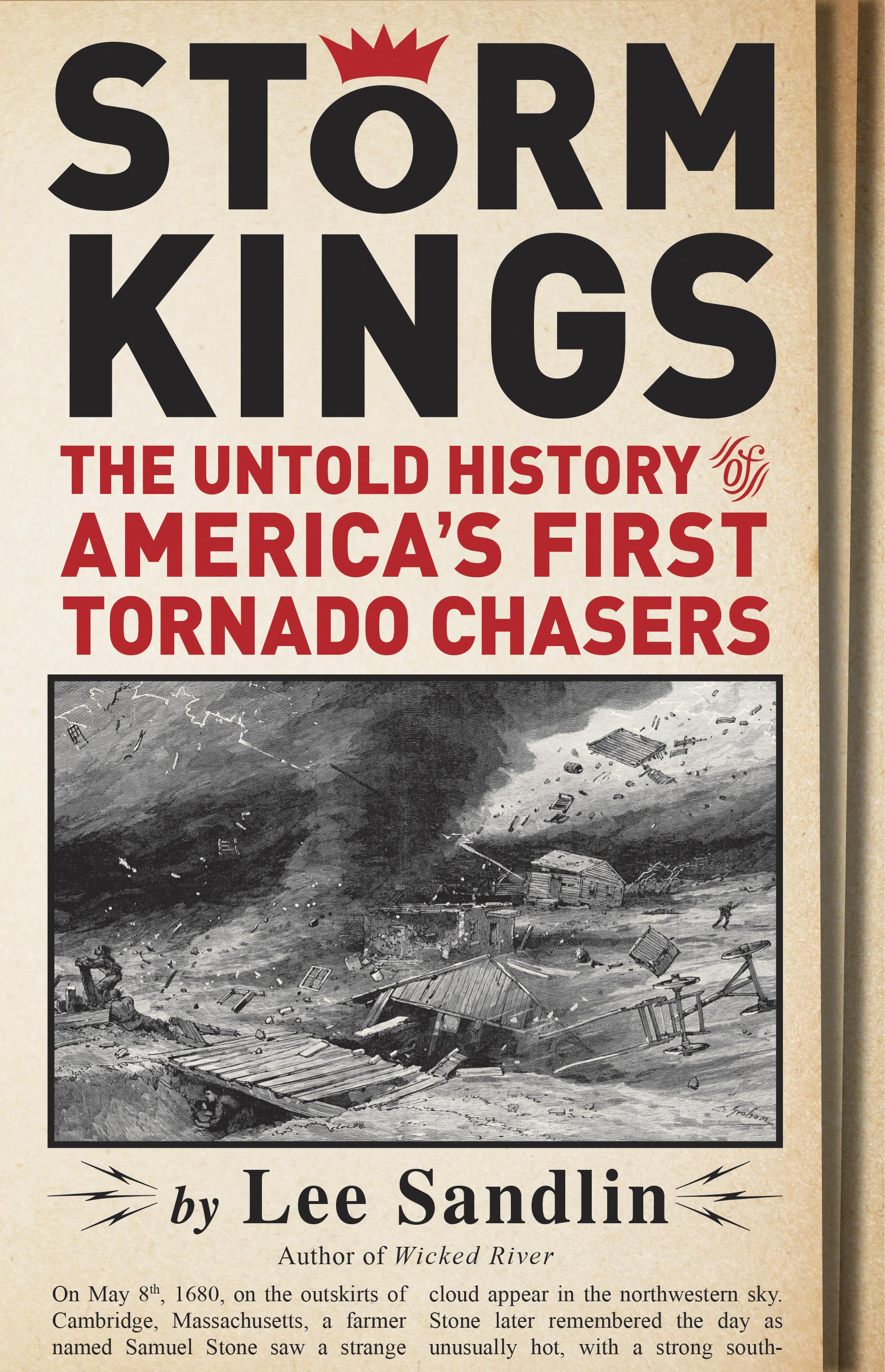
Storm Kings cover (photo: Random House)
CURWOOD: What lessons do you want people to take away from your book?
SANDLIN: I think that one of the things that I would think would be the best lesson is that we think we have a handle on the weather, and the weather still has a lot of surprises. Things like tornadoes may turn out to be inherently uncontrollable and unpredictable. We have a tendency to believe sooner or later we will get control of all of the phenomena of the Earth, and I don't think that's really ever going to happen.
CURWOOD: Lee Sandlin’s book is called “Storm Kings: the Untold History of America’s First Tornado Chasers.” Thanks so much, Lee.
SANDLIN: This has been a pleasure.
Related links:
- Lee Sandlin’s website
- Storm Kings on Amazon
- Storm Kings ebook available from Random House
[MUSIC: Storm King Q&A: Jimi Hendrix “Hey Gypsy Boy” from People, Hell and Angels (Sony Legacy 2013)]
Whales at Home in the Caribbean

Humpback whale (photo: bigstockphoto.com)
CURWOOD: Each year, humpback whales migrate, some traveling as much as 16,000 miles round trip. They spend their summers in nutrient-rich cold waters where they feast on krill and small fish. And then, for the winter, the humpbacks head to warm tropical waters where they cosy up, mate, and give birth. Living on Earth’s Bobby Bascomb recently found the whales delighting tourists just offshore in the Dominican Republic.
[BOAT RIDING ON WAVES]
BASCOMB: Some 50 visitors from around the world lean over the rail of the whale watching boat Porto Mia. They scan the clear blue waters of the Caribbean Sea, searching for humpback whales.
[CROWD CHEERING]
FABIAN: Oh, there he is right there! Right there, he’s up! Do you see the whale? Maybe it’s a she actually, who knows? Oh right there!

Humpback breaching (photo: bigstockphoto.com)
BASCOMB: There are three separate populations of humpbacks world wide. One group lives in the Southern Hemisphere, another in the Pacific Ocean, and a third in the Atlantic Ocean. And the three populations never meet. The north Atlantic group feeds in the Gulf of Maine, or off the coast of Greenland and Norway but almost all of them come here, to the Dominican Republic, to mate or give birth.
BEDDALL: That makes them Dominican citizens. They’re born here, they hold Dominican passports. They go north to feed. They always come back to the country where they were born.
BASCOMB: Kim Beddall is a marine mammal specialist. She’s been studying humpback whales for 30 years here in the Dominican Republic.
BEDDALL: They do not eat here for 5 to 6 months every year, so they’re living on a stored layer of body fat that they’ve accumulated in their northern feeding grounds. Baby humpback whales are drinking 200 liters of milk every day and growing at 100 pounds daily. And a mother is producing all that milk and she’s not feeding herself. So a female humpback whale will lose about 25 percent of her total body weight the winter she gives birth.
BASCOMB: No one knows for sure why the North Atlantic humpbacks choose the Dominican Republic for their nursery, but Beddall has a theory
BEDDALL: This is probably the closest most appropriate place where the entire population can mix. The mother might be a whale that feeds in the Gulf of Maine and the father might be a whale that feeds in Norway and that guarantees a genetic difference in order to produce healthy offspring.
[WHALE CALLS]
BASCOMB: A hydrophone the crew dropped into the water records the sounds of a lone male humpback trying to sweet-talk a female.
[CROWD ON BOAT]
BASCOMB: There are actually more humpbacks in Dominican waters now than just a few decades ago. Since 1966 the population has risen from roughly 1,000 individuals to 16,000. North Atlantic humpbacks are no longer considered endangered, but Kim Beddall says that doesn’t mean they are safe.
BEDDALL: Humpback whales are coastal animals. This brings them into contact with human activity. So if you combine aboriginal whaling with entanglements in fishing gear, ship strikes, global warming, contamination of their feeding areas and reproductive areas, there’s a lot of threats to humpback whales in all the world’s oceans.
[PLAINTIVE WHALE CALLS]
BASCOMB: Of all the humpbacks in the world’s oceans, the Dominican group is arguably the best protected.
BEDDALL: Our National Marine Mammal Sanctuary here in the Dominican Republic is sister sanctuary to Stellwagen Bank National Marine Sanctuary off the coast of Boston. So, we’re protecting them here in their reproductive area and off the coast of Boston in one of their feeding areas.

A humpback at sunset (photo: bigstockphoto.com)
BASCOMB: And that’s where all those whales are heading now, to feast on krill in the cold, food rich waters of the North Atlantic.
For Living on Earth, I’m Bobby Bascomb in Samana, Dominican Republic.
Related link:
Whale Samana website
[MUSIC: Electric Light Orchestra “The Whale” from Out Of The Blue (Epic Records 1977)]
CURWOOD: Living on Earth is produced by the World Media Foundation. Naomi Arenberg, Bobby Bascomb, Emmett Fitzgerald, Qainat Khan, Helen Palmer, Adelaide Chen, James Curwood, Jennifer Marquis and Gabriela Romanow all help to make our show. Jeff Turton is our technical director. Alison Lirish Dean composed our themes. You can find us anytime at LOE.org, and check out our Facebook page, it’s PRI’s Living on Earth. And we tweet from @LivingOnEarth. I'm Steve Curwood. Thanks for listening.
ANNOUNCER: Funding for Living on Earth comes from Stonyfield Farm, makers of organic yogurt, smoothies, and more. Stonyfield invites you to just eat organic for a day. Details at justeatorganic dot com. Support also comes from you, our listeners, The Go Forward Fund and Pax World Mutual and Exchange Traded Funds, integrating environmental, social and governance factors into investment analysis and decision making. On the web at Pax World dot com. Pax World, for tomorrow.
ANNOUNCER 2: PRI Public Radio International.
Living on Earth wants to hear from you!
Living on Earth
62 Calef Highway, Suite 212
Lee, NH 03861
Telephone: 617-287-4121
E-mail: comments@loe.org
Newsletter [Click here]
Donate to Living on Earth!
Living on Earth is an independent media program and relies entirely on contributions from listeners and institutions supporting public service. Please donate now to preserve an independent environmental voice.
NewsletterLiving on Earth offers a weekly delivery of the show's rundown to your mailbox. Sign up for our newsletter today!
 Sailors For The Sea: Be the change you want to sea.
Sailors For The Sea: Be the change you want to sea.
 The Grantham Foundation for the Protection of the Environment: Committed to protecting and improving the health of the global environment.
The Grantham Foundation for the Protection of the Environment: Committed to protecting and improving the health of the global environment.
 Contribute to Living on Earth and receive, as our gift to you, an archival print of one of Mark Seth Lender's extraordinary wildlife photographs. Follow the link to see Mark's current collection of photographs.
Contribute to Living on Earth and receive, as our gift to you, an archival print of one of Mark Seth Lender's extraordinary wildlife photographs. Follow the link to see Mark's current collection of photographs.
 Buy a signed copy of Mark Seth Lender's book Smeagull the Seagull & support Living on Earth
Buy a signed copy of Mark Seth Lender's book Smeagull the Seagull & support Living on Earth

